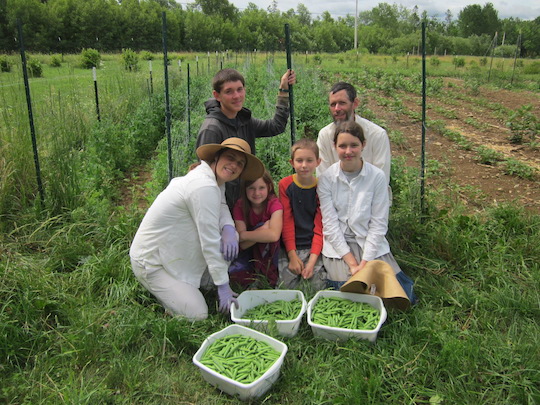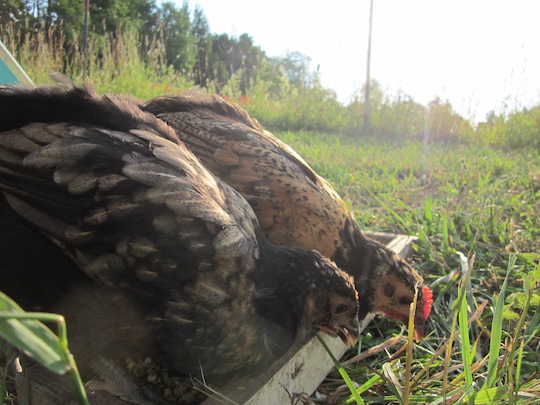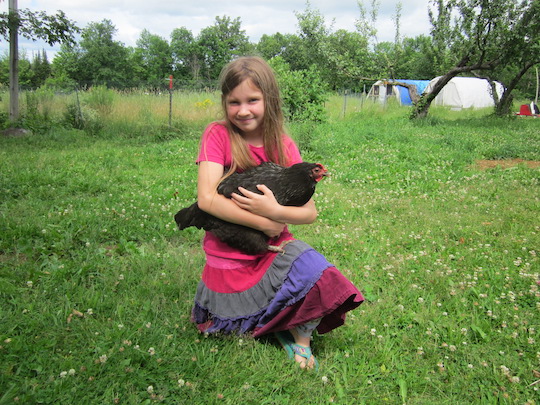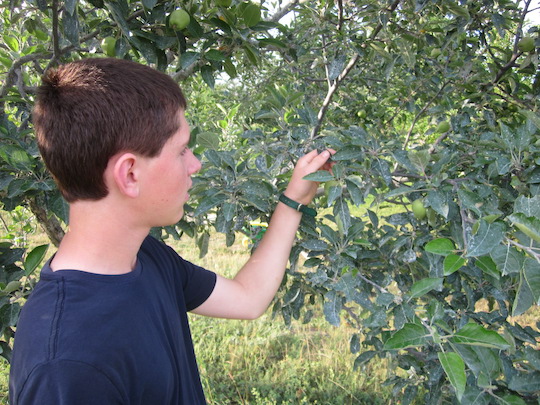By Sonja Heyck-Merlin
In Denver, Colorado, Steve Farr was a full-time computer systems engineer at a university and later at a consulting firm. “Being gone 10 to 12 hours a day, I felt like I hardly knew my children,” he says. “I wanted to do something different, and my wife Kari and I came to an agreement about farming. We moved to Maine to have a vocation that we could do together.”
Maine’s climate — literal and figurative — appealed to the Farrs, even though neither had ever stepped foot in the state. Colorado was too dry, and Steve says there were too many regulatory hurdles with selling farm goods. In Maine, they felt, there was abundant water, reasonable homeschooling regulations and relative ease in selling farm goods.
They arrived in August of 2013 and rented through November, before purchasing their property in Troy, Maine. It has 10 acres of open land and 16 acres of forest.
Steve continues to generate the family’s income as an internet technology and cybersecurity consultant. He is able to minimize his hours in the summer, so he can focus on the homestead, and then ratchets them up in the cold months. He’s happy to now live without a cell phone and jokes he no longer has to be worried about being woken at 2 a.m. by someone at the university who can’t access Justin Bieber’s website. Instead, he’s getting a good night’s sleep in preparation for a busy day on the homestead with the family. He and Kari have four homeschooled children: Andrew (16), Allison (14), Evan (11) and Hayley (8).

Of their 10 open acres, one-third of an acre is in mixed vegetables with another one-third acre in pasture for their flock of laying hens. They also have a hazelnut grove and apple orchard, each measuring an acre. A neighbor with a beef herd puts up hay on the rest of the open land.
“For the vegetables,” Steve says, “we have a seven-year crop rotation pattern, using seven gardens in succession. We plant corn and wheat the first year, followed by shelling peas and nightshades in year two, and then beans in year three. Year four is garlic and five is cucurbits. Grain sunflowers, root vegetables and lettuce come in year six, with a full year of green manures and fertility development in year seven of the rotation.”
Each of the seven gardens is 2,500 square feet. While the Farrs have a single moldboard plow and set of discs that they can pull with a Simplicity Landlord lawn tractor, for most tillage they typically use a 36-inch rototiller on the tractor.
Six of the gardens have a pollinator band running lengthwise, splitting the gardens into two equal halves, planted to annuals like cosmos, poppies, dill and ornamental sunflowers. Steve says the dill is their go-to decoy crop and between planting it in the pollinator band and interplanting it with their winter squash, they rarely see squash bugs. The dill also seems to help repel striped cucumber beetles and tomato hornworms. “Our long-term goal is to not till the flower bands once we get to a place where we’ve depleted the weed seed bank,” Steve says. Once they accomplish this, they hope to add perennials to the bands.
The vegetable gardens provide the family with the majority of their produce with some surplus to sell. Their gardening efforts don’t just end with a full belly, though; the cycle is not complete without seed saving. “It’s not so much that we don’t want to buy seeds from other people. If anything, we’ve learned how dependent we really are on others. The seed saving originates from a desire to preserve the lost skill of maintaining breeds, rather than taking blindly whatever is being sold,” Steve says.
They currently maintain their own seed stock for potatoes, tomatoes, garlic, wheat, grain sunflowers, shelling peas, dry beans, flint corn and some winter squash and pumpkins. 2021 is their first year experimenting with saving carrot, beet and parsnip seed. They hope to expand the amounts of seed they have available to sell for the 2022 growing season.
Selecting which seed to save is different for each species. With beans and peas, Steve says they select for healthy plants that do well without succumbing to disease. More specifically, they look for plants with a heavy set and long pods full of seeds.
“As we harvest peas or beans, the kids get to participate as plant geneticists,” Steve says. “They are trained that if they find a plant that looks awesome, they don’t harvest it.” That way the seeds will mature on the plant, rather than being consumed as food. Beyond meeting homeschool science objectives in the garden, the selection is resulting in more productive varieties. When they started saving Penelope shelling peas, their definition of a seed plant was one bearing a pod with seven peas, now it has 12. “The cultivars really do adapt, change and respond to how you select over time,” Steve says.
Another open-pollinated variety they maintain is Banatka wheat, selecting for high-yielding plants that don’t bend over (known as lodging). They also maintain seed stock for cucurbits, including Delicata and Acorn winter squash as well as some pumpkins.
To select cucurbit seed stock, the Farrs look for healthy plants with fruits that mature early, marking these plants during the growing season. “Beyond that,” Steve says, “we try to eat a lot of squash. The ones that are yummy, we collect seeds from.” Because the different varieties of cucurbits that the Farrs grow are all Cucurbita pepo and easily cross-pollinate, Steve says he doesn’t anticipate selling the seed.
The garlic varieties they grow are German Stiffneck and a German Red type. For this crop, selection is based on the size of the head and number of cloves per head. “The Stiffneck has so few cloves per head, that a lot of the crop ends up going back to seed. With this variety, our goal is to select for more cloves without compromising size. In the six years that we’ve been running the Stiffneck, we’ve gone from four cloves to now asking it to do six or seven,” Steve says.
Through cross-pollination, some of their seed has taken on a life of its own. Two of their favorite tomato varieties — Peacevine cherry and Amish Paste — have coalesced into one, something that the family likes better than either of the individual varieties. Their flint corn, which they refer to as Hilltop, is a cross between Strubbes Orange, Jerry Peterson Blue, Nothstine Dent and Mandan Bride. “At first, the corn plants leaned towards one cultivar, but it’s its own thing now. Hilltop doesn’t look like any of its parents,” Steve said. With the corn, they select for tight husks, corn moth resistance and strong, stable plants that can handle drought conditions.
Since carrots and parsnips are easily cross-pollinated by wild species, growing these seeds is an experiment for 2021. As biennials, both crops need to overwinter in order to set seed. “This is the first year we’ve had enough stored roots to put back in, and we’re not trying too hard to isolate them right now, even though we have lots of Queen Anne’s Lace.” They planted both the carrot and parsnip roots densely and, according to Steve, they are statistically likely to be pollinated by each other. “We want to see how it goes this year and then see how aggressive we get about isolation,” he says.
The Farr plant geneticists are also poultry breeders, raising a chicken breed they refer to as Black Golds — a genetic merging of the Buff Orpington and Black Australorp breeds and some latent Araucana genes. The chickens and some guinea fowl are currently the only livestock on the homestead.

From their flock of 25 overwintered hens, they select up to 16 broody hens and isolate them from the rest of the flock in what they call “the baby pasture.” Each hen has their own shelter while they are setting and rearing their clutches. The Black Golds they are developing are dual-purpose, bred for a combination of egg and meat production. They also select for growth and laying performance on a soy-free diet because the Farrs believe that chickens are healthier without soy.
In 2021, they hatched about 100 chicks. “We really love this process,” Steve says. “The hens do all the work and we get to enjoy taking care of the moms and their chicks.” The female chicks are weighed and their pelvic width is measured at 14 weeks — the latter measurement can be used as an indicator for selecting good egg layers. Those with the most desirable traits get put back into the breeding program; the average ones become layers and some are processed for meat along with the male chicks.
“We select rigorously for the cocks we use in the breeding program, selecting for pelvic width and length, weight and disposition,” Steve says. “We will not tolerate a man-fighter. It’s like a reality show where a different one gets voted off each week.”
The third of an acre devoted to the layer program has a perimeter fence built with chicken mesh with 2-inch spacing. It’s further divided into five paddocks that they rotate the laying flock through; each paddock is connected to the layer barn, a 16-by-12-foot homemade hoop house. For bedding, they use leaves, creating a deep litter that is put on the corn rotation in the garden each spring.
While the Farrs do sell some eggs and pullets, they don’t foresee expanding the layer program. “The breeding part is the most interesting and exciting part of the poultry. Though we love them, the eggs are a by-product of the breeding program,” Steve says.

Between the rhythms of gardening, drying and storing seed, poultry chores, homeschooling and household tasks, there is ample opportunity for each of the Farr children to engage with the farm. Andrew, the oldest, is the catalyst of their expanding commercial orchard, which contains 25 two-year-old trees and 50 that are a year old. There are another 20 grafted trees in a nursery to be planted into the orchard in 2022.
According to Andrew’s orchard website, varieties are chosen from a wide range of heirloom apples like Maine’s Black Oxford or Canadian Strawberry, and little-known modern apples with exceptional flavor, such as Frostbite, Chestnut Crab or Keepsake. Disease-resistant varieties, such as Red Free, complete the range of types represented in the orchard. Andrew’s plan is to eventually plant another acre or two of a few varieties selected for popularity and pest and disease resistance. Eventually he wants to build a cider barn.
“I am encouraging Andrew to spend the bulk of his free time in the orchard,” Steve says. “He still helps out with other aspects of the farm, but he needs some freedom to development his own future.”
The other children are all engaged with the farm in their own different ways, driven by what aspects are the most delightful to each of them. Allison daydreams of having a horse, maybe a combination draft and riding horse. “If we ever get there, it’s because Allison learns it and brings the animal husbandry to the homestead. First though, we would need to have a barn,” Steve says.

Evan is the equipment person, and Steve tries to involve him whenever anything machinery-related comes up. Hayley, Steve says, simply loves being outside, helping in the orchard and gardens or lending a mothering hand to newborn chicks.
Though there are family expectations and required chores, Steve and Kari’s goal is to make sure they manage the family farm experience in a way that fosters a love of the land, food and reaping the rewards of hard work. “We try not to push too hard and look for signs of burn-out. If that happens, we try to do something different like head down to Unity Pond for a swim,” Steve says.
Looking forward, Steve says one of the most challenging decisions is when and how to take the step from homesteading to a more commercial enterprise, allowing him to step away from his off-farm job. Right now, the business is generating some revenue, primarily from seed, poultry and produce sales and sometimes from bread and canned goods that Kari produces.
“We’re in the incubation phase,” Steve says. “We were recently certified organic and obtained a commercial kitchen license. We’re practicing what will work and what will make money. Once we’re confident, it will be time to make the shift.”
Regardless of when or how this shift occurs, Steve says the family has grown a lot closer since they’ve been farming together, and he’s really thankful for that. This is echoed by Andrew: “I think one of my favorite things about our homestead lifestyle is the fact that it enables us to work as a family. As we improve our fields and weed our crops, we’re also getting to spend time together. After a long season of work, the results of our labor belong to all of us.”
About the author: Sonja Heyck-Merlin is a regular feature writer for The MOF&G. She and her family own and operate an organic dairy farm in Charleston, Maine.
